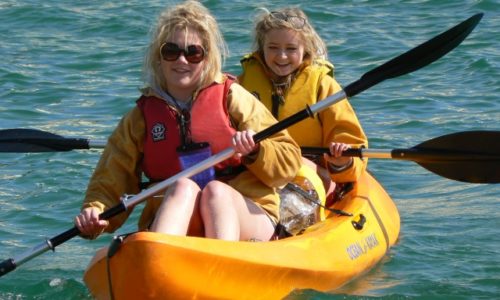No activity, be it water based or land based, can be totally risk free. However, we do our best to provide you with the best equipment and knowledge, so that you can enjoy your time on the water in the safest way possible. Our licenses to operate are renewed annually when we are inspected by the Truro Harbour Master, under the authority of the MCA (Maritime and Coastguard Agency). The kayaks are fully insured by specialist marine insurer Navigators and General, and we have up to £3,000,000 Public Liability cover.

The kayaks are virtually unsinkable and will float when fully swamped. You will be provided with a Crewsaver or Gul buoyancy aid correctly fitted for your size. These are tested each year in accordance with BCU (British Canoe Union) guidelines to ensure they retain their buoyancy. A visual check is also carried out to make sure there is no adverse wear and tear. A record is kept of all testing.
The kayaks are inherently stable, that’s not to say you won’t fall in if you try hard enough! Being sit-on kayaks you will not be trapped inside. Either re-board the kayak or swim to the shore, which you should never be far from. You will be provided with a dry bag so you can take a mobile ‘phone with you . You will also have a simple chart of the area. Take a look at the Kayak Guidelines, Conditions of Hire and Kayaking Chart pages for further information. During the early part of the season a wetsuit is advisable.
On some occasions you will be able to paddle up the Percuil River, but will be advised against going out into the more open waters of The Carrick Roads, due to the sea conditions prevailing on the day. This advise must be adhered to.
If you do capsize, re-boarding procedure- ensure the kayak is the correct way up. Imagine you are getting out of a swimming pool, but don’t put all your weight on the edge of the kayak you will just flip it over. You need to try and get your weight over the middle of the kayak and then scramble aboard.
Don’t keep struggling; after a couple of attempts swim for the shore, and we’ll worry about the kayak afterwards.
Over the last few years the RNLI has seen a huge increase in the number of call-outs to rescue inexperienced kayakers and paddle-boarders. So please listen to our advice on the day, paddle within your limits, stay close to the shore, think about the paddle back (it will be more difficult against wind and / or tide), and be aware of changing conditions. PADDLE SAFE.
We have never had any serious incidents, and I would very much like to keep it that way!
I hope the above answers any safety concerns you may have. Please feel free to ask any questions on any aspect of your kayaking experience. Please take a look at the FAQ page as well.


